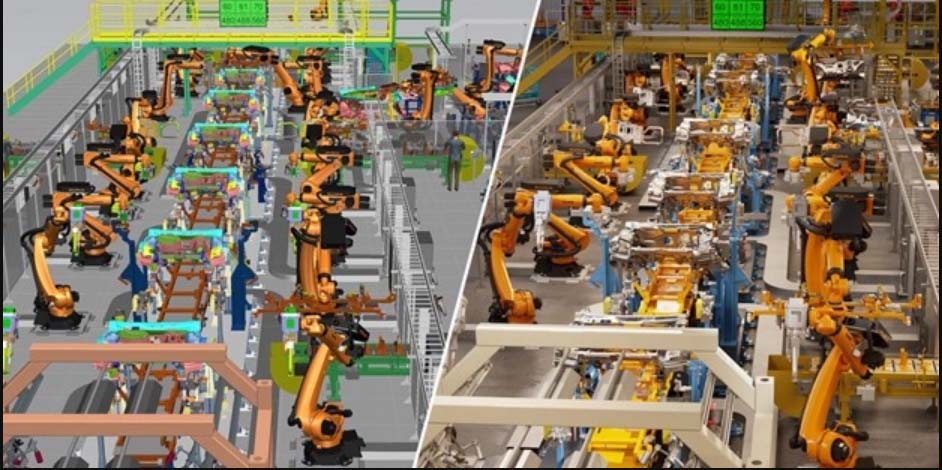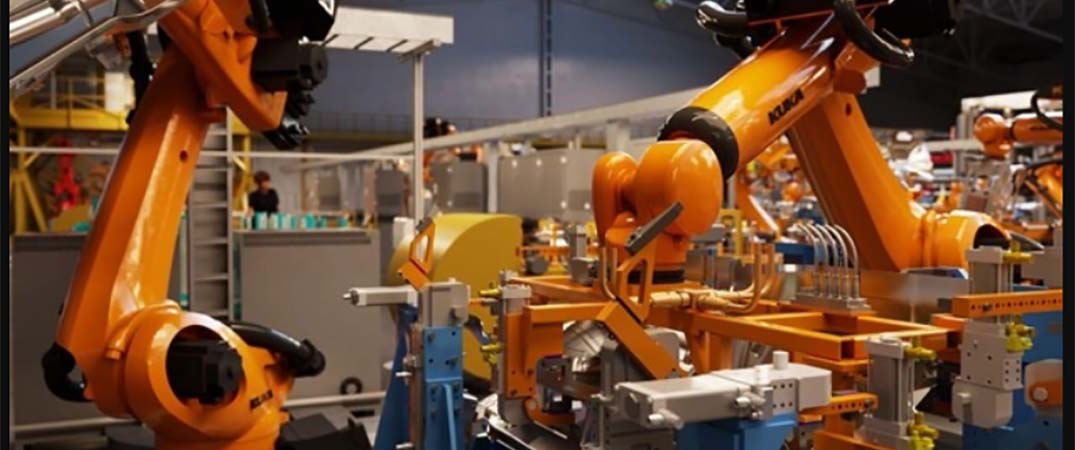Siemens and Nvidia have launched Siemens Xcelerator business platform in Munich, with the aim of driving the “industrial metaverse”.
“When we combine the real and digital worlds we can achieve new levels of flexibility and we can bring new products to market faster,” says Siemens CEO Roland Busch, during an event at Siemens’ Munich headquarters.
Pairing physics-based digital models from Siemens with real-time AI from Nvidia, the companies announced they will connect the Siemens Xcelerator and Nvidia Omniverse platforms.

The connection between Siemens Xcelerator (left) and Nvidia Omniverse (right) will enable customers to develop full-design-fidelity, closed-loop digital twins.
“With our two companies we can connect what Siemens makes with what NVIDIA makes, to AI and Omniverse,” comments Nvidia founder and CEO Jensen Huang. “We can now fuse data from the point of design, all the way through product life cycle management, all the way through the automation of plants to the optimization of the plant after deployment — that entire life cycle can now be in one world.”
Bringing the real and virtual worlds together
Siemens Xcelerator is a business platform that includes internet of things-enabled hardware, software and digital services from across Siemens that offer a comprehensive digital twin that can bring together the mechanical, electrical and software domains.
Siemens is a leader in industrial automation and software, infrastructure, building technology and transportation, and their solutions are used across the manufacturing lifecycle from designing products and the equipment to manufacture those products in factories to controlling and tracking how the equipment moves to orchestrating the flow of people, parts and machines across the factory itself.
The company has built a rich portfolio of hardware and software solutions that are part of the Siemens Xcelerator platform that is now at the centre of an ecosystem of more than 50 certified partners.
The Nvidia Omniverse 3D collaboration and simulation development platform delivers photorealistic rendering capabilities and advanced AI to the Siemens Xcelerator ecosystem, allowing the digital twin to be represented in full-design fidelity, and operating in real time.
Working side by side
Milan Nedeljkovic, a member of the board of management of BMW, comments: “The digital twin itself is not the challenge.”
He outlines BMW’s plans to create sophisticated digital models of its manufacturing process that are linked, in real time to real-world factories. “The challenge is to link into this digital twin the existing systems one by one, and to have any change in the digital twin being reverted in the original planning tools.”
Transforming businesses
With the connection of Siemens Xcelerator and NVIDIA Omniverse, manufacturing customers of any size will be able to immediately analyze issues, identify root causes, and simulate and optimize solutions, thanks to the AI-infused, real-time photorealistic virtual environments, according to Busch and Huang.
So, for example, if something goes wrong on the factory floor, teams of users from around the world will be able to meet, virtually, to collaborate and use the connected digital twin to quickly identify, troubleshoot and solve the problem.
The partnership also promises to make factories more efficient and sustainable. Users will more easily be able to turn data streaming from the factory floor PLCs and sensors into AI models. These models can be used to continuously optimize performance, predict problems, reduce energy consumption, and streamline the flow of parts and materials across the factory floor.
Under the hood
The partnership brings together complementary technologies and ecosystems, according to the two leaders.
Innovating at the intersection of real and digital worlds, Siemens offers a digital twin by representing the mechanical, electrical and software domains interacting, Busch explains.
Nvidia Omniverse is a multi-GPU scalable virtual world engine that enables teams to connect 3D design and CAD applications for collaborative design workflows and allows users to build physically accurate virtual worlds for training, testing and operating AI agents such as robots and autonomous machines.
For example, energy and utility plant engineers can virtually navigate through the live digital twin of a facility to analyze the thermal distribution produced by the existing air conditioning. system from Siemens simulations.
Then they can explore different vents and cooling towers configurations, powered by use the of Omniverse’s full-design-fidelity visualization capabilities enabled by real-time ray- and path-traced rendering.
Ultimately every component inside a factory can be inspected and optimized — and eventually, automated by AI. A robotic conveyer belt could be trained to alert an operator when the conveyor motor is undergoing excessive energy draw due to improperly greased rollers, saving time and maintenance costs, for example.
Advancing digital twins
These innovations will reach not just from the cloud to the factory floor, but across industries, Busch and Huang explains.
“You know, if you look at almost every engineering project today of any significant complexity, we simulate the product before we go to production,” Huang says. “And yet, for most plants and most factories, it’s nearly impossible to do that today … and so we needed to create a very large-scale simulation platform: Omniverse.”
The addition of Siemens Xcelerator to the Omniverse ecosystem will enable domain-specific digital twins, using the rich design, manufacturing and operational data from Siemens’ mechanical, electrical, software, IoT and edge solutions in Omniverse.
“The world’s industries represent hundreds of trillions of dollars over time,” Huang says, adding that finding even small efficiencies in such huge systems is a huge opportunity. “That’s one of the reasons why people want to invest and now we have the technology capability for them to do so.”
Featured pic: Teams will be able to meet and collaborate in Nvidia Omniverse’s real-time, photorealistic virtual environment.

